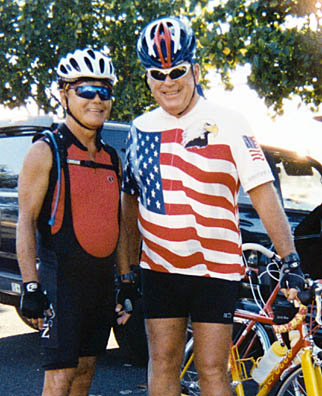— ADVERTISEMENT —


|
Accident victim
remembered as
an avid cyclist
To Al Ostermiller, cycling buddy Ernest Sakai will always be "the Shadow."
"When we would ride, we rode so close together," Ostermiller said. "He was in back of me. He was always on my wheel. Certain times of the day, even though there were no words being spoken, I could feel him and the only thing I could see was his shadow."
They developed a strong trust and a close friendship. Trust is important in cycling since a rider needs to watch a friend's back, warn him about the car pulling out or the dog running out, Ostermiller said.
So when Sakai's daughter called Saturday with the news that Ernest had been killed while bicycling, Ostermiller said, "My first thought was I should have been there."
The 68-year-old Hawaii Kai man died after a pickup truck driven by a 22-year-old East Honolulu woman struck him on Kalanianaole Highway near Kaimoku Place.
Police said she may have lost control of the steering wheel while trying to move into the left lane and instead veered right into the bike lane.
Police opened a negligent homicide case against the woman, who police said may have been speeding. She and a 2-year-old boy riding with her were uninjured.
Just six to eight weeks ago, the two men shared a conversation about how good life was.
And the two men agreed on one thing: "When we check out, we gotta be on the bike, not in a hospital bed. That's how we felt. That's our honest love of cycling."
Ostermiller said the two met eight to 10 years ago when he joined a Sunday group of seasoned cyclists as the rookie.
Eventually, he and Sakai, both retired, rode three days a week. Their friendship blossomed.
But in November, Ostermiller had hip replacement surgery, and stopped bicycling. Sakai also biked less. But in March or April, the two got back in the saddle again, gradually improving their pace and riding religiously. On Sundays, Ostermiller's wife joined them.
But Sakai wasn't keeping pace and may have felt he was holding Ostermiller back. So Sakai told Ostermiller, he'd call when he felt ready to rejoin him and began riding alone between 18 miles and 30 miles at a time.
Ostermiller described Sakai as a positive person who never complained about his health or anything else. He never said a negative word about anyone, even if a driver cut them off while riding.
And anything Sakai got involved in, he became an expert at, reading up on the subject, from caring for his meticulous lawn and garden to raising finches to cycling, Ostermiller said.
Sakai also adored his wife, children and grandchildren, whom he took to Sea Life Park and Chuck E. Cheese.
He also told Ostermiller, "My wife, all these years, she's been taking care of me, now it's my turn," and vowed to spend more time with her.
He also returned to work part-time as a head custodian at 1051 Wilder Ave., enjoying the contact with people, Ostermiller said.
Ostermiller hopes Sakai's death will help motorists realize that a cyclist could be someone you know, someone's husband, father, grandfather and friend.
Two years ago, the men lost a friend from that original bunch of cyclists, Vernon Izuka. The 61-year-old died 100 yards from the spot where Sakai was killed.
Charles Rosa-Coleman, executive director of the Hawaii Bicycling League, said Sakai, a member of the advocacy group, appeared to be doing everything right in what is considered a high-quality bike lane.
"Motorists have to understand that their moment of inattention can cost someone who's not protected by two tons of steel their life," he said. "And cyclists need to understand that even when they're doing the right thing, they need to ride defensively and know that they're in danger at all times."
— ADVERTISEMENTS —
— ADVERTISEMENTS —